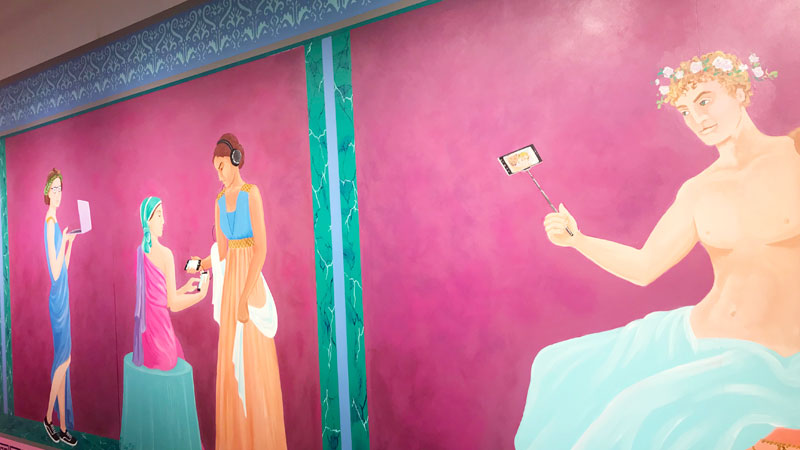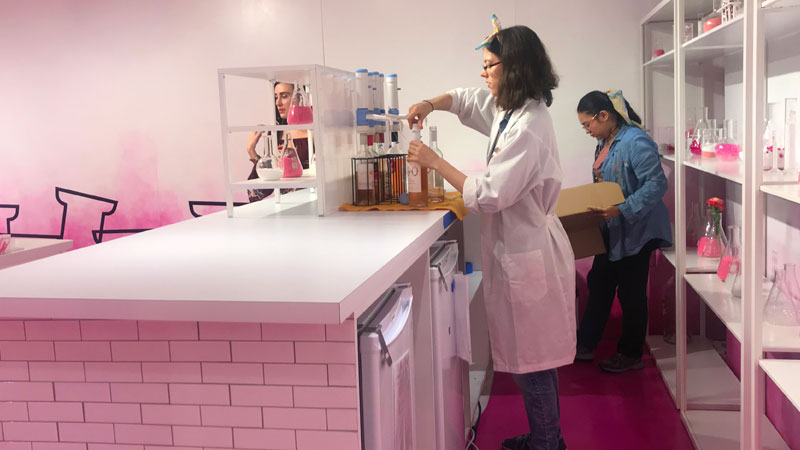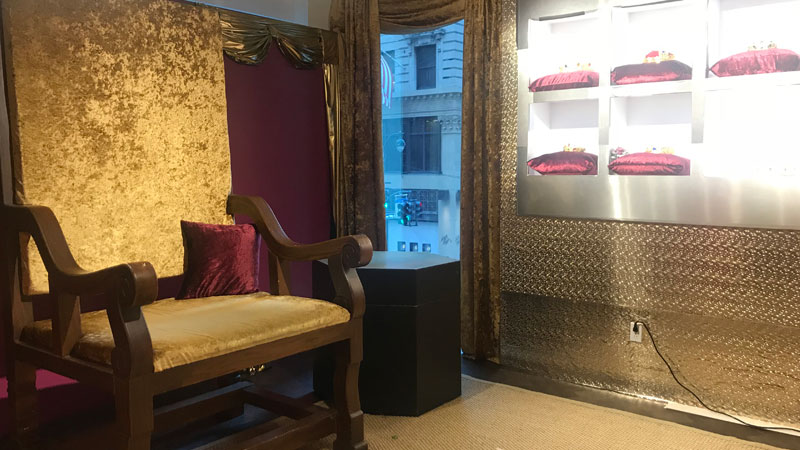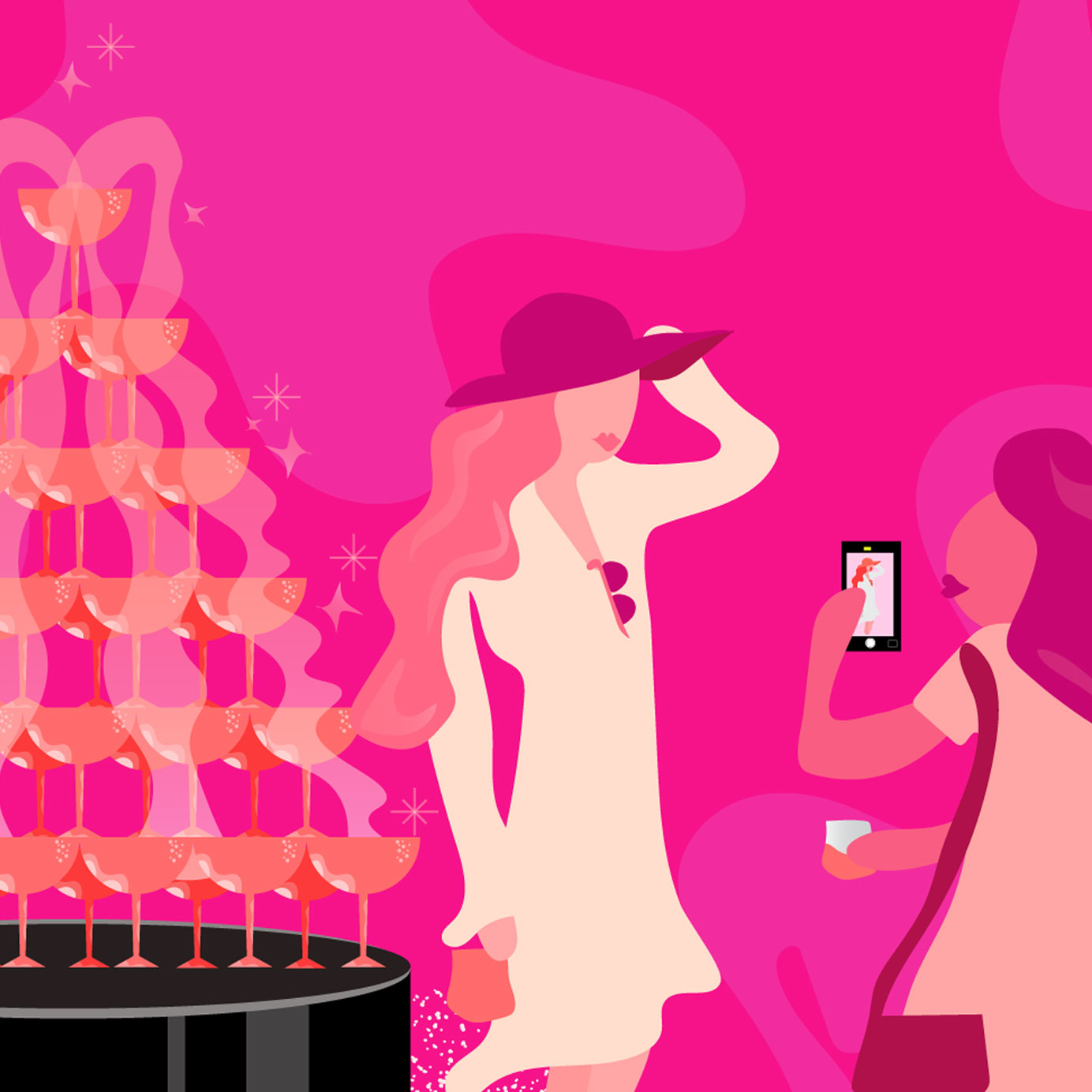Depending on your personality, New York City’s Rosé Mansion either sounds like a lot of fun, or a total nightmare indicative of everything wrong with modern society. In reality, it’s both.
Launched in July 2018, the Rosé Mansion is comprised of a bar, gift shop, and seven individually designed rooms dedicated to what the website calls “the history, science, and economics of this magical beverage.”
It’s essentially a rosé set piece for Instagram, akin to the money-raking ice cream-, egg-, and candy- themed pop-ups that have recently debuted in NYC, San Francisco, and Los Angeles. So how should we feel about them?
“Much of the debate around these selfie magnets focuses on what to call them,” Emily McCormick writes in Bloomberg, thereby coining a pretty solid category name. “Are they institutions with cultural value? Or are they ‘braindead, Instagram-optimized fun houses?’” she asks, quoting a newsletter from Jason Farago, editor of the art magazine Even.
As with many rosés, the answer is a blend. Art and commerce are not mutually exclusive, and something lacking intellectual depth can still be culturally meaningful. (Remember “I Wanna Hold Your Hand”?)
Some 500 to 750 people reportedly visit the Rosé Mansion nightly. Last week, I was one of them.
What It Is
The Rosé Mansion spans two stories within an otherwise-unremarkable Midtown Manhattan highrise. The front door is flanked by a bouncer checking IDs, and a merch counter selling pink tank tops and branded water bottles.
Every $45 ticket guarantees timed access to the Mansion, followed by a self-guided, one-hour tour; eight 1-ounce pours of rosé (approximately 1.5 glasses of wine); a commemorative plastic cup and pin; and infinite Boomerang opportunities. Those with flexible schedules can book a $35 “Happy Hour” ticket, available on weekdays before 4:30 p.m.
At the end of every tour lies the Grand Tasting Lounge, a clubby bar that purports to have the largest rosé collection in the world. Wines by the glass start at $12.

What It’s Like
Last Wednesday, a colleague and I redeemed our tickets and joined a group of stylishly dressed, ethnically diverse, mostly female millennials for a 5:30 p.m. tour. Kayla, an affable greeter, recited some ground rules for us to repeat before we entered.
“I promise not to stand on anything that swings,” we chanted in unison. “I promise to respect the rules of the Rosé Mansion.”
Then Kayla waved us through, and pink recess was officially in session.
The “rooms” span seven cordoned-off areas of a sprawling industrial loft. At “Science of Sweet,” we sampled a grapefruit gummy bear alongside a pour of Maison Marcel. The “Roman Room” was loosely connected to Italy, and decorated with murals of selfie-taking toga wearers. The “World of Wine” was designed to look like a travel agent’s office, a concept that is probably unfamiliar to every visitor to the Rosé Mansion.
Certain rooms seemed openly promotional, such as Apothic’s “Secret Garden,” and a “Made in NY” station where a cheery staffer poured Dr. Konstantin Frank rosé in front of a sign that read, “Visit The Finger Lakes.”

The “Sparkling and Champagne Dreams” room was especially popular the day we visited, thanks to its adult-sized ball pit. According to an interview with co-founder Tyler Baillet, the ball pit is meant to convey what it feels like inside a glass of Champagne.
“Someone cut herself in there this morning,” Tanya*, the employee tasked with monitoring the pit, told me. Guests are advised to remove all jewelry before entering, but a stray earring was lost and never found. “I mean, we can’t clean out the entire ball pit every day,” she added.
A former waitress, Tanya applied for her job at the Rosé Mansion because she was eager to learn about wine. Like most staffers I encountered, she was kind and epically patient, even though her job hazards included wrangling rosé-happy strangers on an adult playground.
“Be careful on those steps,” I heard her say multiple times. “Everyone gets 45 seconds in the ball pit, and then it’s time for the next group to get a turn.”
“I’m always happy to explain the wines to people, but no one really wants that,” Jonathan*, a pourer in the “French Throne” section, said. He was literally and figuratively overshadowed by an oversized chair upholstered in gold crushed velvet. “They come for the experience, not the wine.”
Or, as Elisabeth Sherman wrote in Food & Wine, “If you want to learn about rosé, there are books for that. If you want to put on a pink dress and stand in front of a wall covered with roses, there’s now a mansion for that. It looks beautiful, and for the half an hour you’ll spend wandering the Rosé Mansion’s hallways, that’s all that needs to matter.”
What’s Wine Got to Do With It?
I’m embarrassed to admit my colleague and I spent a good portion of our visit snarkily whispering about the AstroTurf in the closet-sized Rose Garden, the visible power cords, weak pours, and inaccurate vinification information on signage no one but us was reading. It’s easy to mock an endeavor like the Rosé Mansion. I did.
We were especially poor sports at the Blending Lab, where a woman in a lab coat squirted several varietal wines into every guest’s glass. It was supposed to demonstrate the art of blending grapes, but it was actually the alcoholic equivalent of the “suicide” fountain sodas my siblings and I made at 7-Elevens growing up. And, like Mountain Dew plus Cherry Coke plus Sprite plus Dr. Pepper, these “blended” wines tasted terrible.
But no one around me cared. Glasses were clinked, snapped, drained, and passed to the next pourer.

Why? Because everyone at the Rosé Mansion was having a really, really good time. They were living their best lives. A group of friends in matching coral jumpsuits excitedly explained that they didn’t plan to coordinate their outfits (“We just walked out of the hotel rooms wearing them!”). Everyone offered to take pictures of everyone else. After the tour, the majority of visitors stuck around to get wine-drunk at the cash bar downstairs.
Every guest I encountered seemed legitimately happy to be there. I struggle to name one other place in midtown Manhattan that fits that description.
We Got the Pink
If you hate the Rosé Mansion on principle, you’re not wrong, but you are missing the bigger picture. It represents an enormous market of wine fans eager to self-identify with “rosé” as a brand. Instead of viewing them as digitally minded dolts, we should embrace them, and seek ways to translate their enthusiasm into support for the industry.
A ticketed Instagram attraction might sound tacky or pandering, but it could do major good. What if for every pour of the Edna Valley or Rock Wall rosé on offer at the Grand Tasting Lounge, the Rosé Mansion donated $1 to California wildfire relief? What if it also offered $46 tickets, from which $1 would be used to fund opportunities for underrepresented communities in wine?
This might sound revolutionary. Or it might sound depressingly opportunistic. Like the Rosé Mansion itself, I think it’s both.
* Names have been changed to protect identities and employment.
